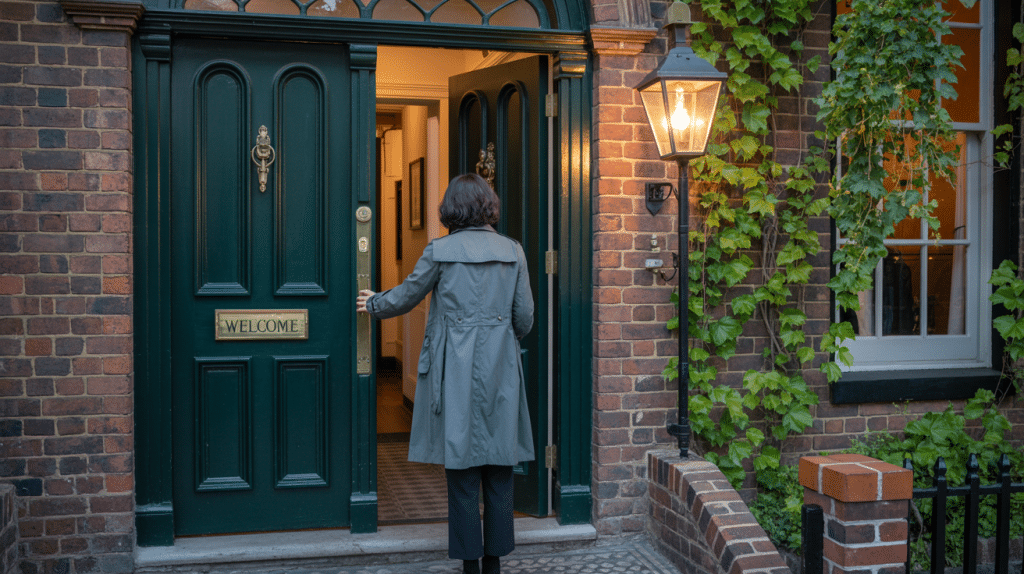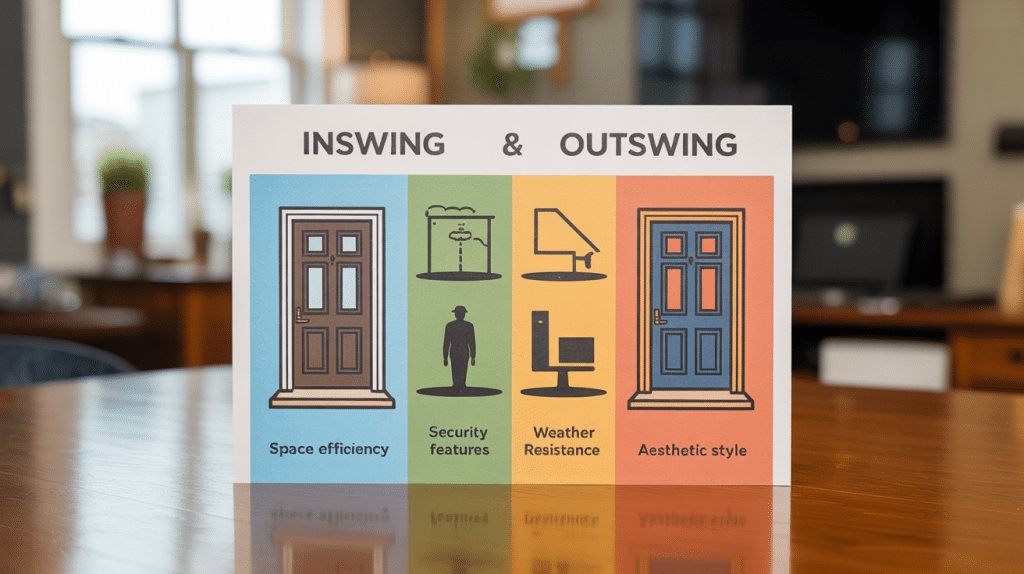Ever walked into a door because it opened the “wrong way”? Ouch! That’s not just embarrassing, it might be a sign your home has the wrong door swing.
Choosing between inswing and outswing doors isn’t just about looks. It affects how you use your space every single day.
Think about it. The way your door opens can make a tiny bathroom feel bigger. It can keep rain and snow outside where they belong. It might even make your home safer.
But here’s the thing: what works for your neighbor’s house might be all wrong for yours.
This guide will walk you through everything you need to know about door swings. By the end, you’ll know exactly which door type is perfect for your home.
Inswing and Outswing Doors: Understanding The Basics
The direction of the door swing affects functionality, security, and space utilization in your home, making the proper selection crucial for comfort and safety.
Inswing Doors

- Inswing doors open toward you and into the room. Imagine yourself standing in your living room, pulling the front door handle toward you to get inside. That’s an inswing door.
- These doors are common in most homes. When you’re inside and want to go out, you push the door away. When you’re outside and want to come in, you pull it toward you.
Outswing Doors

- Outswing doors do the opposite – they open away from you and toward the outside. Imagine standing inside your home and pushing your door to open it outward.
- With these doors, you pull when you’re outside wanting to come in. You push when you’re inside wanting to go out.
The main difference? It’s all about which way the door moves when you open it – into your home or away from it. Such a small detail, but it makes a big difference in how you use your space.
What Are the Benefits and Limitations of Inswing and Outswing Doors?
Let’s break down what’s great (and not so great) about each type of door so you can pick the perfect one for your home.
| Feature | Inswing Doors | Outswing Doors |
|---|---|---|
| Weather Protection | Keeps weather outside, tighter seal against rain and wind. | Can let rain sneak in easier, less weatherproof. |
| Aesthetic Appeal | Looks nicer from the outside (no hinges showing). | Might look odd to neighbors since it’s less common. |
| Space Usage | It takes up room inside the house and needs clear space to swing. | It saves indoor space and doesn’t require room for swinging. |
| Security | It’s easier to kick in and less secure against forced entry. | It is more secure and harder to force open. |
| Compatibility with Screen Doors | Works well with screen or storm doors. | Cannot easily add a screen door. |
| Room Size Compatibility | Not ideal for small rooms (e.g., small bathrooms). | Perfect for small rooms, like tiny bathrooms or closets. |
| Weatherproofing | Better weatherproofing stops cold air. | Can get blocked by snow or bad weather, no protection from snowdrifts. |
| Familiarity | Feels familiar, everyone knows how to use them. | May be unfamiliar or awkward for some users. |
| Emergency Use | Can be tricky to open in emergencies due to space constraints. | Easier to exit quickly in an emergency. |
| Potential for Obstruction | Can hit furniture or objects nearby. | Can hit people standing outside. |
Inswing vs Outswing Doors: Quick Comparison

Can’t decide which way your door should swing? This simple chart shows exactly how each type works, so you can pick the perfect door for your home.
| Feature | Inswing Doors | Outswing Doors |
|---|---|---|
| Opens | Into your home | Away from your home |
| Space | Needs room inside | Needs room outside |
| Hinges | Hidden inside | Visible outside |
| Security | Easier to break in | Harder to break in |
| Weather | Good in rain/wind | May leak in heavy rain |
| Snow | Gets stuck in snow | Works fine in snow |
| Look | Normal, common | Different, unusual |
| Room size | Makes rooms smaller | Saves indoor space |
| Screens | Works with screens | No screens possible |
| Best for | Living areas, entries | Bathrooms, tight spaces |
| Price | Costs less | Costs more |
| Installing | Easy to put in | Needs special seals |
| Emergencies | Harder to exit fast | Easier to exit fast |
| Maintenance | Simple care | Must protect hinges |
How to Choose the Right Door Swing for Your Home?
Stuck between inswing and outswing doors? Here’s a simple guide to help you decide which one fits your home best.
1. Security Considerations
Inswing doors are easier to break into because someone could kick them in. But their hinges are safely hidden inside.
Outswing doors are much harder to kick open. However, their hinges are outside, and someone could mess with them.
Best for: If you live in an area with break-ins, outswing doors with special security hinges might be better. For most normal neighborhoods, either type works fine with good locks.
2. Weather and Climate Impact
Inswing doors work like a cork in a bottle during rainstorms – wind and rain actually push them tighter against the seals. But in snow, they can get stuck if snow piles up outside.
Outswing doors can handle snowy days much better – just push, and the snow moves out of the way. But heavy rain might lead to leakage.
Best for: If you live at a place with frequent rain, inswing doors are great. If you’re in a snowy place, outswing doors would be a better fit.
3. Space Availability and Layout
Inswing doors need about 30 inches of clear space inside your room.
Outswing doors save your indoor space but need clear space outside.
Best for: If you have tiny rooms (like small bathrooms), go with outswing doors. For normal-sized living rooms, inswing doors work fine. Outswing doors are perfect for closets too.
4. Local Building Codes and Regulations
Inswing doors are allowed in most homes, but some cities have special rules.
Outswing doors are often required in public buildings for safety.
Best for: Most homes can use either type, but check with your local building office first. If you have a home business where customers visit, you might need outswing doors.
5. Personal Preferences and Style
Inswing doors look normal and familiar. They have a wide usage.
Outswing doors look different and are less common.
Best for: If you like traditional homes, inswing doors fit better. If you have modern tastes or love being different, outswing doors stand out.
Wrapping Up: What’s Best for You?
Now you know all about inswing and outswing doors. Both have good and not-so-good points to think about.
Inswing doors look normal and keep the rain out better. But they need room inside and can get stuck in the snow.
Outswing doors save space and work great in snowy areas. They are harder to break into. Just remember they need special hinges.
Your perfect door depends on your area’s weather, your space, and what you prefer. There’s no wrong choice – just the right one for your home.
Ready to decide? Grab a tape measure and check your space. Then, visit your local home store to see both door types in person. Share a picture of your new door when it’s installed.
Frequently Asked Questions
Is It Better To Have An Inswing Or Outswing Front Door?
It depends on your home’s layout, climate, and security needs- inswing doors are common and good for weather protection, while outswing doors save interior space and offer better security.
Is It Against the Code To Have An Exterior Door Swing Out?
No, many local building codes allow exterior doors to swing outward, especially for safety reasons like emergency exits, but it’s best to check your local regulations.
Can You Change A Door To Swing Out Instead Of In?
Yes, but it involves rehanging the door, adjusting the frame, and ensuring proper weather sealing, so a professional best does it.


